What is a channel split system: types and device options
It is better to consider issues of ventilation and air conditioning even before building a house, at the design stage. Especially if you plan to install a built-in structure - for example, a duct system.This is a well-known fact.
If you are planning to build a house or do major renovations in an old home, it would be a good idea to find out what a ducted split system is and how it works. The initial theoretical knowledge presented in this article will help you choose the right air conditioner, as well as understand its design and types.
You will learn everything about the design specifics and operating principle of ducted climate control equipment from the article we presented. We will talk about the varieties of this type of equipment used in conditioning. We will introduce you to the technical characteristics and installation nuances.
The content of the article:
What are duct split systems?
There are many technically complex engineering solutions that are being implemented in factory workshops, multi-storey shopping, entertainment and sports centers. More often these are multi-systems, equipped with additional devices and associated with ventilation systems.
An effective built-in air conditioning system has proven itself in servicing industrial, public, and entertainment institutions, the main feature of which is a large area. But now it is often used to equip private cottages or apartments with high ceilings.
We will take a closer look at the channels split systems, suitable for household use - they are simpler in design, smaller in size, but the basic principles of operation are the same.
Design and operating principle
Channel-type air conditioners are designed, like other similar designs, to maintain a comfortable indoor microclimate. Their peculiarity is that they are designed to serve large areas, which are often divided into separate segments.
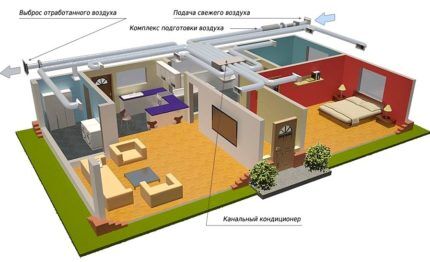
On the market you can find many offers designed specifically for private use - designed for 4-5 rooms, limited length and performance.
The design of a ducted air conditioner completely replicates the structure of a traditional split system: one unit is mounted inside the building, the second - outside. The main difference is that the internal structures are located above suspended ceilings, and are not simply fixed to the wall. There are models that can easily be placed in a closet, as well as wall-mounted air conditioners.
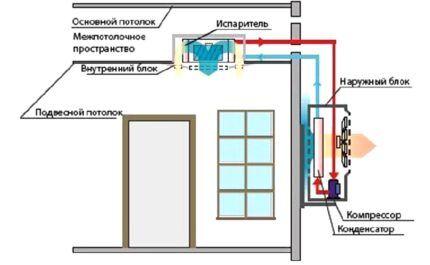
The external unit has standard dimensions and design. It contains components responsible for cooling and uninterrupted operation:
- chokes;
- compressor;
- condenser with heat exchanger;
- fan;
- air filters;
- sensors;
- automation;
- elements of the failure notification system.
Some models that require the removal of large amounts of condensate have a drain pump installed.
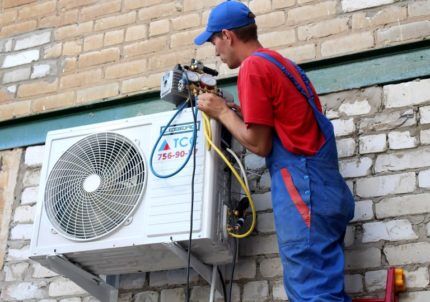
It is important to maintain the manufacturer's recommended installation height difference to avoid technical problems after startup. Internal channels look different depending on the serving area and tasks.
But the filling of the internal blocks is approximately the same:
- evaporator with heat exchanger;
- fan;
- condensate collector;
- electronic board with sensors.
The small number of working elements is justified by minimizing noise in the living space. All parts are assembled in a durable case, which is disguised behind false partitions and ceilings.
Many people choose built-in “invisible” air conditioning systems because of the installation method and aesthetics: only the grilles for air intake or injection go outside.
The fan of the duct device is very powerful. Unlike the conventional axial model, through which air passes freely, it must move volumetric flows with increased aerodynamic resistance.
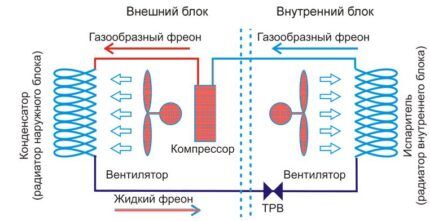
A throttle is installed in the outer part of the circuit, compressing the gas. As a result, the gas condenses and turns into a liquid. When it gets inside the room, it finds itself in a low-pressure zone, heats up, evaporates and again turns into a gas state. Thus, the external radiator is called a condenser, and the internal radiator is called an evaporator.
A special feature of the system is heat transfer due to the conversion of freon from the gaseous phase to the liquid phase and vice versa.In cooling mode, the evaporator coil lowers the room temperature.
But some modern systems operate according to a dual scheme, that is, during the cold period, on the contrary, they can increase the temperature inside the building, of course, within limited limits. Restrictions depend on the outside air temperature. The maximum parameters are usually indicated by the manufacturer in the operating instructions.
Types of built-in air conditioners
Duct split systems are classified according to various technical parameters, but the main one is pressure or pressure, which is measured in Pascals.
Based on the pressure force, structures are divided into 3 groups:
- Low pressure – up to 40-50 Pa.
- With medium pressure – up to 100-150 Pa.
- High pressure – 250-300 Pa or more.
Low-pressure systems are the cheapest and easiest to install. They are installed in domestic premises, offices, and private homes. They are often mounted behind facing panels in corridors and hallways, spacious halls and living rooms.
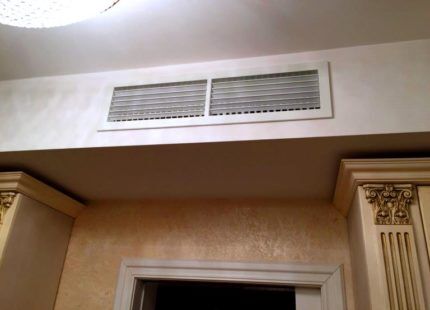
Medium-pressure designs are more complex; they already require a pump to remove condensate. They provide greater air circulation by mixing air from the street.
Medium-pressure structures are installed in large cottages, shops, warehouses, educational and sports centers.
The most powerful high-pressure systems are designed to serve a large number of spacious rooms. They are equipped with an extensive network of air ducts, sophisticated electronics and many sensors.

Duct air conditioners are also divided into:
- ordinary;
- inverter.
The compressor operation of conventional systems is not regulated, so they always operate at the same power, and a simple automatic shutdown is used to control the indoor climate. For this reason, such equipment is also called “Start/Stop”.
The name of inverter systems appeared along with a new element in the design - an inverter, which allows you to smoothly change power.
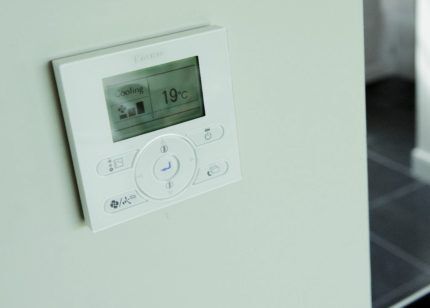
Developers advertise inverter models, often exaggerating their advantages. They claim that newer generation equipment is more economical, quieter and more reliable. But no one has conducted tests and there are no definite statistics on this matter.
Both models are quiet - after all, all “noisy” processes take place in the outdoor unit, on the street. All types of equipment last a long time and over time require only partial replacement of parts. There is debate about energy efficiency because, unlike inverter air conditioner, a conventional split system periodically turns off and does not waste electricity.
But it is already becoming clear that the future lies with inverter split systems. It is on expanding this range that leading manufacturers focus.
There are other ways to divide duct air conditioners into types:
- by appointment (home and industrial);
- by service area;
- according to availability of additional features, for example, air mixing capabilities.
Some classifications are invented by manufacturers - thanks to them, buyers make a choice faster.
Technical characteristics overview
Now let’s look at what characteristics affect the quality of operation of a duct air conditioner. Knowing the exact selection criteria will help you narrow down your choice significantly.
Like any energy-dependent system, duct split systems have a lot of technical data that require attention when purchasing and installing. Let's highlight the most important ones:
You also need to pay attention not only to the length of air ducts, pipes or cables, but also to the dimensions of the duct air conditioner units.
Need to find a place for external unit, suitable for installation conditions, and also calculate the space in the room so that, if necessary, you can service the “filling” of the module. They also produce ultra-narrow models specifically designed for installation in living rooms.
An anti-icing system, an air mass direction system, a function for remembering user-set settings, and adjustable fan speed are welcome.
Advantages and disadvantages in comparison
Duct systems are popular with everyone who cares about a comfortable atmosphere inside the house and at the same time tries not to expose all communications.
Experts in the field of air conditioning and regular users note the following advantages in using duct equipment:
- there is no internal wall unit, which requires space on the wall and often does not fit into the interior design;
- installation of the system ensures good air exchange in all rooms of the house;
- a powerful indoor unit can serve several small rooms;
- Noise from operating elements is reduced as much as possible.
When installing a duct system, you can combine it with ventilation, while saving on both the purchase of equipment and installation.
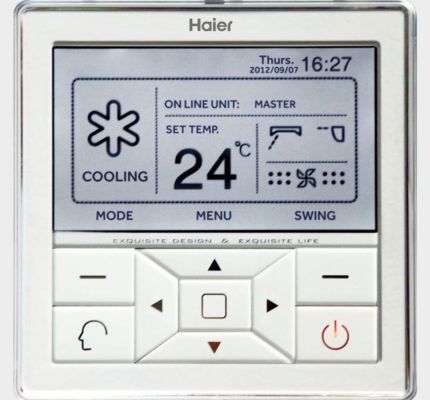
But there are also disadvantages that sometimes persuade home owners to install traditional wall-mounted split systems that are no less efficient, but easier to install.
The disadvantages include:
- complex, requiring additional knowledge and professionalism, installation;
- arrangement of suspended structures to mask channels;
- it is impossible to create different temperature conditions in neighboring rooms - the temperature will be the same everywhere.
But the main problem seems to be competent design, selection, calculation and installation of the structure. It is clear that these are additional costs, and considerable ones. If the system is installed incorrectly, the minimum nuisance will be loud noise echoing throughout the house, and the maximum nuisance will be an expensive remodel.
Conclusions and useful video on the topic
General information about duct air conditioners:
Theory and practical experience:
An example of installing a ducted split system in a city apartment:
For a standard city “two-room apartment” with ceilings of 2.5 or a small country house, which is often used seasonally, during the warm period, a duct system is not needed. But for a spacious apartment with high ceilings or a cottage, a duct-type split system can be the best solution to improve the microclimate in the rooms.
To install the equipment, you will have to make friends with mechanics and installers; you cannot cope with the installation of a technically complex unit on your own. It will be much more expensive than a conventional split system. But the result will be higher - you will get a reliable design that provides you with coolness, warmth, or just fresh air when needed.
Want to talk about how your ducted air conditioning system works? Do you have useful information on a topic that is worth sharing with site visitors? Please leave comments in the form below, post photos and ask questions.



